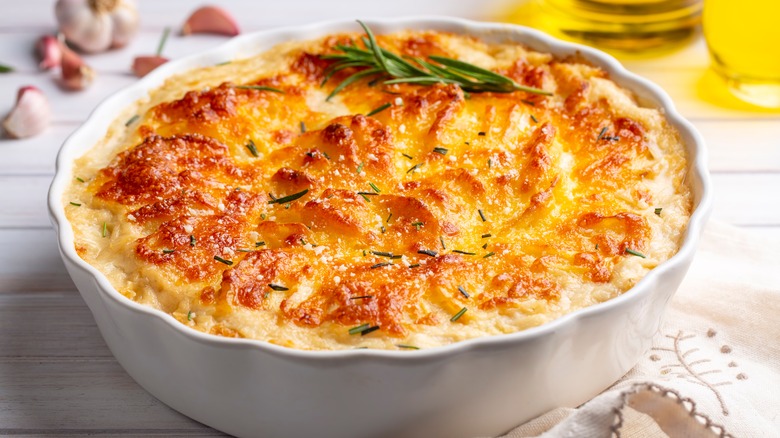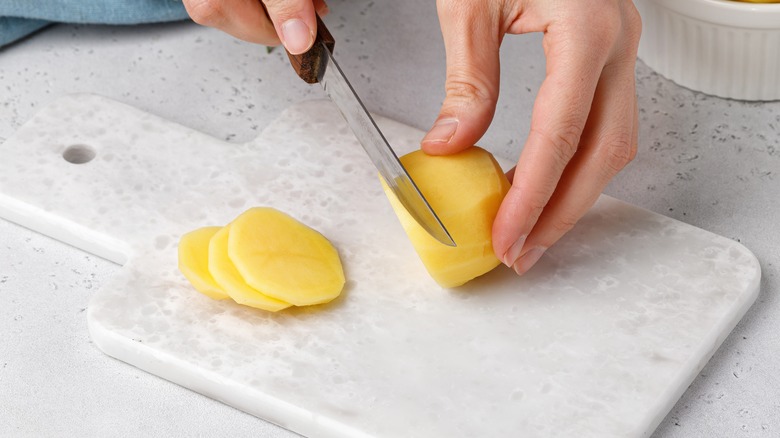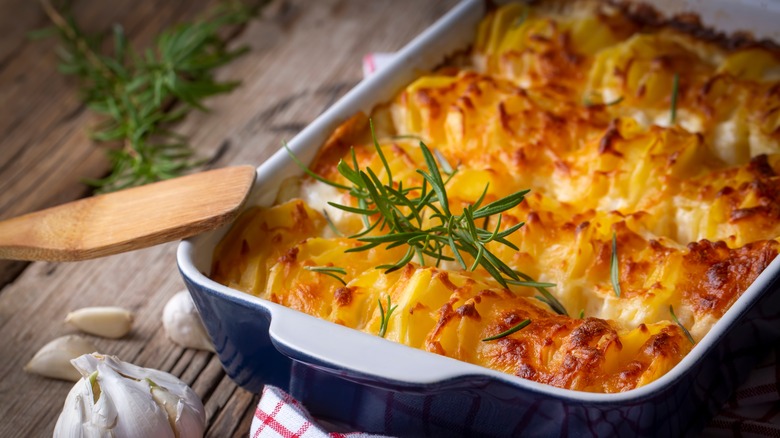The Simple Tip That Will Give Scalloped Potatoes The Perfect Texture
There's something timeless about homemade scalloped potatoes. Thinly sliced potatoes baked with cream and cheese are equally at home at a potluck buffet as they are alongside an Easter ham or a Sunday roast. It's not hard to put together this breakfast, brunch, or dinner favorite as long as you have a simple scalloped potato recipe, but waiting to eat them after they're out of the oven isn't so easy. Even so, patience is important when making scalloped potatoes because they need time to cool down and for their texture to set.
If you dig into your scalloped potatoes right out of the oven, not only will they be molten hot and burn your mouth, but they'll also have a runny texture and be more difficult to cut and serve because the potatoes' starches are still hot and full of moisture. If you let the dish sit for a few minutes, on the other hand, the potatoes will still be warm enough to serve, plus the starches will congeal with the cream and cheese to create a much more pleasing texture.
Let the starch rest
Potatoes are packed with starch, which is important to remember whenever you're cooking them with moisture because the starch expands and contracts depending on the cooking temperature. When potatoes cooked with water, milk, or cooking stock reach around 140–149 degrees Fahrenheit, the starch molecules swell and explode, which is called gelatinization. When they're cooled down, the starches start sticking together again, which results in congealing.
When you boil potatoes for mashed potatoes, for example, it's important to mash them right away after draining the cooking water because the starches immediately start cooling down, which can make the final product gluey. Scalloped potatoes might seem like a different animal since they're baked, but they're actually slowly cooked in milk and cream, and the potato starch thickens this sauce. When you pull the dish out of the oven, the starch molecules are dissolved in the hot cooking liquid, so when you cut a slice, they'll seem runny and thin. When the dish cools down, however, the starches will contract and congeal into a thick, creamy sauce. If you want the best results, let your potatoes rest for 15 to 20 minutes to allow their internal temperature to come down. Treat them like you would an apple pie, which also needs some cooling time before it's cut.
Choose starchy potatoes
Since potato starch is the secret to extra-creamy scalloped potatoes, the type of potato you use makes a difference. Try to use particularly starchy varieties like russets or Yukon golds. Waxy potatoes, like red bliss, fingerlings, or new potatoes don't have the starch power to really thicken up the sauce, so save those varieties for roasting or for making potato salad.
Also important is not to rush your scalloped potatoes in the oven, which is why a good recipe will keep the temperature at around 350 degrees Fahrenheit. You want the potatoes and cream to heat slowly so that the potatoes release their starch and the flavors are combined. If you cook the dish too hot, the dairy will curdle and won't meld with the potato starch, which will result in a clumpy, oily sauce.
If you've got scalloped potatoes on the menu either for a weeknight dinner or for your next event, remember that they need time to cool before you serve them. Plan your cooking time accordingly; don't wait to take them out of the oven until it's time to serve. Set aside a little extra time for resting, and you'll always have the creamiest, dreamiest scalloped potatoes possible.


